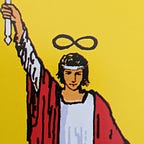Death: Beginning of a Transition
This year seems to be full of death. Though I doubt it’s any different from previous years, it just feels particularly prevalent — Kobe Bryant, Chadwick Boseman, Justice Ruth Bader Ginsburg, Sean Connery, and yesterday, Alex Trebek, not to mention all those who’ve lost their lives to the pandemic or due to the colour of their skin. While it initially felt a bit rough to start a Monday with the Death card, it now feels fitting for the start of a new week.
Three things make me feel better about death: 1) everyone dies, without exception, which comforts me because it is an experience we can share and connect over, 2) destiny or a higher power rules when death appears, which is liberating because it takes it out of our hands and even removes blame, and finally 3) death is not the end we think it is, it is a transition (a surprise one at that since no-one knows what happens after!)
13. DEATH
What you see: A skeleton dressed in a dark suit of armour, rides a white horse with red eyes over a fallen king. He holds a black banner with a five-petaled white rose on it. In front of him, stands a bishop with his hands together pleading. Also kneeling near the bishop is a young woman with her head turned away and a child. In the background the sun sets between two towers and a lone boat sails down a river.
What it means: Death’s messenger is a skeleton, the part of us which remains, covered in armour and signifying invincibility — death inevitably comes. The white horse stands for power and purity, and the banner reflects beauty and purification: the five-sided rose represents change. The tableau indicates that even kings will fall and no one can escape death. The ship in the background represents the boat that sails down the River Styx ferrying the dead to the afterlife. Finally, even the sun sets signalling the end of the day.
The story: As a character, death represents the end or destruction, however this is followed by a renewal or rebirth. As an event, it indicates a major change, transformation or transition. As a relationship, it may represent letting go of what may not longer be working but opens up the possibility for new and better opportunities. As a sign, it calls to end an aspect of your life that may not be serving you.
As part of the Fool’s Journey: Death is the final test of the realizations from the previous cards; it is not physical death of the fool but maybe the loss of a loved one and entering into unchartered territory.
Reversed meaning: If drawn upside-down, it represents resistance to letting go or not making a meaningful change that is necessary.
In mythology: In the book of Revelations, the first of the four horseman (Death) rides a white horse. Thanatos is death personified in Greek mythology. He is the son of Nyx, Goddess of the Night, and brother of Hypnos, God of Sleep. He appeared to humans to carry them off to the underworld when the time allotted to them by the Fates had expired.
Potential insights: Death does not mean the end with a period. It leaves room for a comma that is followed by something different and possibly even better. Though we may not necessarily see it like this, death is necessary and balances the universe: it is not something to be feared.
My takeaway from this card is to think of death as a checkpoint in our journey, not the finish line. Funerals are an opportunity to celebrate the life that we got to witness and share in, and to wish the person all the luck in the next stage of their journey.
My research sources:
A Complete Guide to the Tarot, Eden Gray, 1970
Tarot Card Meanings, Biddy Tarot
Deck: The Rider-Waite Tarot Deck®
